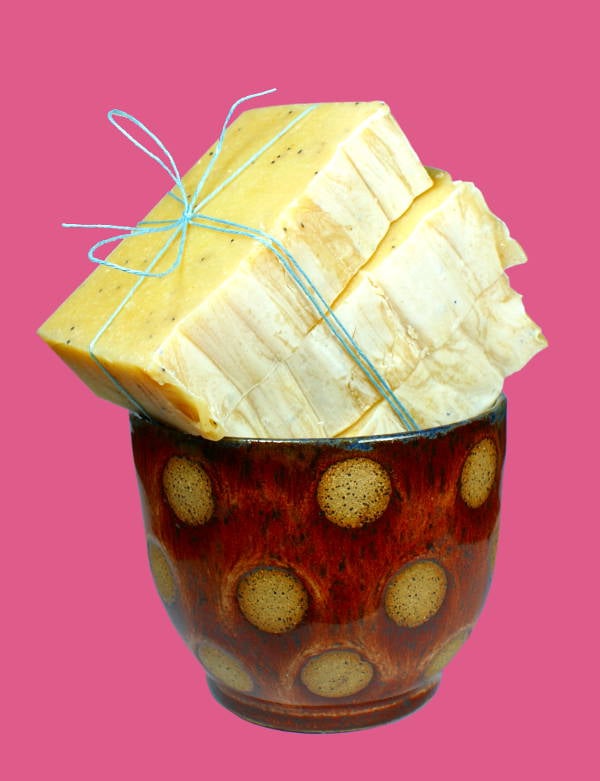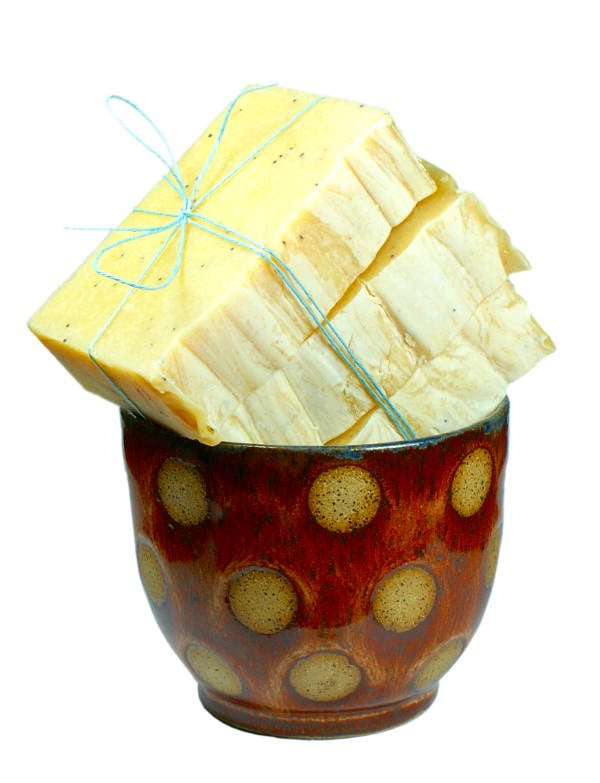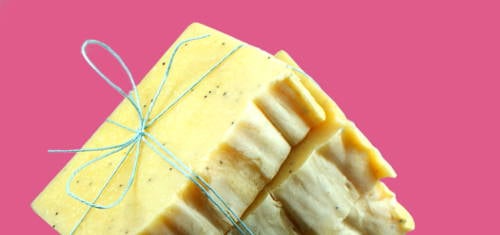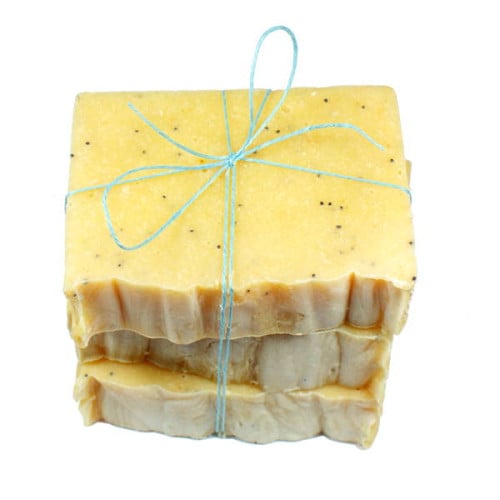
Lemon & Poppyseed Nut Free Soap Recipe

This simple homemade nut free soap recipe contains zero nut oils so even those with nut allergies can enjoy this classically scented lemon poppyseed soap. While coconut oil traditionally boosts lather in homemade cold process soap recipes, this nut free soap recipe instead uses palm kernel flakes which has similar lather boosting properties. In addition it also incorporates less costly ingredients for those who are soaping on a budget.

Lemon & Poppyseed Nut Free Soap Recipe
Ingredients:
9 oz. palm kernel flakes
10.8 oz. sustainable palm oil
14.4 oz. rice bran oil
1.8 oz. castor oil
11.8 oz. distilled water
4.9 oz. lye/sodium hydroxide
1.1 oz. lemongrass essential oil
1 teaspoon turmeric root powder
1 teaspoon poppy seeds
Soap Notes:
Water as % of oils=33%
7% superfat
This nut free soap recipe will yield 10-12 bars of soap approximately 4 oz. each depending on how they are cut and fits inside my DIY wooden loaf soap mold.
You can substitute sustainable palm kernel oil for the palm kernel flakes in this homemade soap recipe without having to make adjustments to the amount of lye needed. You can also substitute pomace olive oil for all or half of the rice bran oil if desired. You won’t need to run this nut free soap recipe back through a lye calculator if you aren’t resizing the batch or changing it in anyway. However, if you are resizing the batch for any reason, be sure to run the numbers back through a lye calculator.
The turmeric powder in this homemade soap recipe is used for a natural color to give the soap more of a yellow pop of color. It is optional. The lemongrass essential oil does make this soap yellow on it’s own, it’s just not as deep of a yellow color.
Instructions:
To make this natural lemon and poppyseed nut free soap recipe, you’ll need to follow your basic cold process soapmaking method instructions. (If you’ve never made cold process soap before here’s another good, inexpensive beginner’s cold process soap recipe you can try.) Be sure to take all proper safety precautions when working with lye including goggles and gloves.
Begin by measuring out the distilled water in fluid ounces. Pour into a heat safe pitcher. Next, using a digital scale weigh out the lye. Slowly pour the lye into the water in a well ventilated area and stir until all the lye has dissolved. Set aside to cool.
Now weigh out the palm kernel flakes, palm oil, rice bran oil and castor oil using a digital scale and combine in a stainless steel pot. Heat until melted, then remove from heat and set aside.
Next weigh out the lemongrass essential oil and set aside. Use a measuring spoon to measure out the turmeric powder and poppy seeds and set these aside as well until you’re ready to make your soap.
Once the lye-water and soapmaking oils have cooled to around 90°-95°F you’re ready to make this nut free soap recipe.
Add the turmeric powder to the soapmaking oils and mix with a stick blender until fully incorporated.
Now you’ll slowly pour the lye-water into the soapmaking oils. Mix with a stick blender until you reach a light trace, then add the essential oil and poppy seeds. Mix again until the soap starts to thicken again and all ingredients are fully blended into the soap, then pour the soap into your prepared mold.
Palm oil tends to trace quickly as well as heat up a lot, so I didn’t cover this soap once it was poured into the mold.

After 24 hours you can unmold your homemade nut free soap loaf and cut it into bars. Allow your soaps to cure 4-6 weeks before use, then wrap and label as desired.
For more of my homemade soap recipes as well as bath and beauty DIY’s be sure to visit Rebecca’s Soap Delicatessen. You can also follow me on Pinterest for collections of not only my homemade soap recipes and beauty DIY’s but also some of my favorites from around the web.
Keep track of all my new homemade soap recipes and other DIY creations by following Soap Deli News blog via Blog Lovin’ and Tumblr. You can also find me on Facebook, Twitter, G+ and Instagram.



8 Comments
Od
March 9, 2015 at 5:53 am
Nice one! Palm oil is from palm nuts, the same with palm kernel flakes. I think a nut free soap would have rice bran oil, neem oil and perhaps water melon seed or pumpkin seed oil?
Rebecca D. Dillon
March 9, 2015 at 4:46 pm
Palm kernel oil is actually from the seed of palm fruit and one with a tree nut allergy wouldn’t necessarily be allergic to palm kernel oil unless they have a specific allergy to palm kernel oil.The same with palm oil. Palm oil comes from the fruit portion of palm and from what I’ve researched is not considered a tree nut and does not have tree nut proteins. Palm oil is considered safe for those with tree nut allergies assuming they don’t also have a separate allergy to palm oil in addition to a tree nut allergy. The same with coconut oil though I’ve had customers previously who were allergic to coconut oil which is why I chose to omit it in this recipe even though coconut oil is also supposedly unrelated to tree nuts. There’s a source here, but other information seems to hold the same.
Emily L
March 16, 2015 at 4:55 pm
Hi Rebecca! I made this soap over the weekend and it smells wonderful! I did, however, get a partial gel “fail” on the color. I knew it would get hot, so I left it uncovered and popped it into the freezer for 45 min or so, then put it out on my back porch (it’s still chilly here — about 45 degrees). I unmolded it today, and while the texture and smell are beautiful, I would call it “ugly soap”, for sure. Any suggestions on whether I can rebatch something like this? And how I should go about doing that so it won’t have the color issue? My turmeric made it lean towards an orangey-peachy hue, too, so I will probably be re-making this one, minus the turmeric and maybe adding some lemon peel.Thoughts? Thanks!!
Rebecca D. Dillon
March 16, 2015 at 8:18 pm
I’ve never put my soaps in the freezer so I can’t offer any advice there. (I always have let my soaps gel.) However you can always rebatch the soap with a bit of milk or water to even out the overall look. Mine was a little orangey-yellow from the tumeric when I first unmolded it but as it’s cured it’s a beautiful yellow. I’m not sure about the lemon peel as I’ve never used it to try to color a soap. Yellow oxide would definitely give you a yellow “yellow.” Perhaps someone else has input on using natural colorants for yellow hues.
Yasmeen
October 4, 2015 at 8:05 pm
Hi,
I’m loving your website. I’m a newbie to soap making.
I have few questions. I have red Palm oil that I use for cooking and regular olive oil eould I be able to use them in this recipie?? I don’t mind getting a diff color.
Please let me know. Thanks:)
Yasmeen
Rebecca D. Dillon
October 4, 2015 at 8:12 pm
Yes, you can. Sometimes grocery store olive oil is tricky though and doesn’t perform as well as olive oil sold specifically for soapmaking. Olive oil from Sam’s Club does work great, however. Red palm oil will give the soap a rich orange color while refined palm oil does not.
Yasmeen
October 5, 2015 at 10:12 pm
Thank you Rebecca 🙂
Nel
November 11, 2015 at 11:55 am
Thank you. I’m glad to find this recipe as a friend of mine is very allergic to coconut. However, she discovered she is not allergic to palm oil, so I’ve been able to make a simple soap for her using vegetable shortening (it has hydrogenated palm but no coconut). I’ve read online that people who have a coconut allergy are likely to have a palm allergy too (since the trees are from the same family) but thankfully she doesn’t. Just thought I’d share. Thanks again!
Comments are closed.